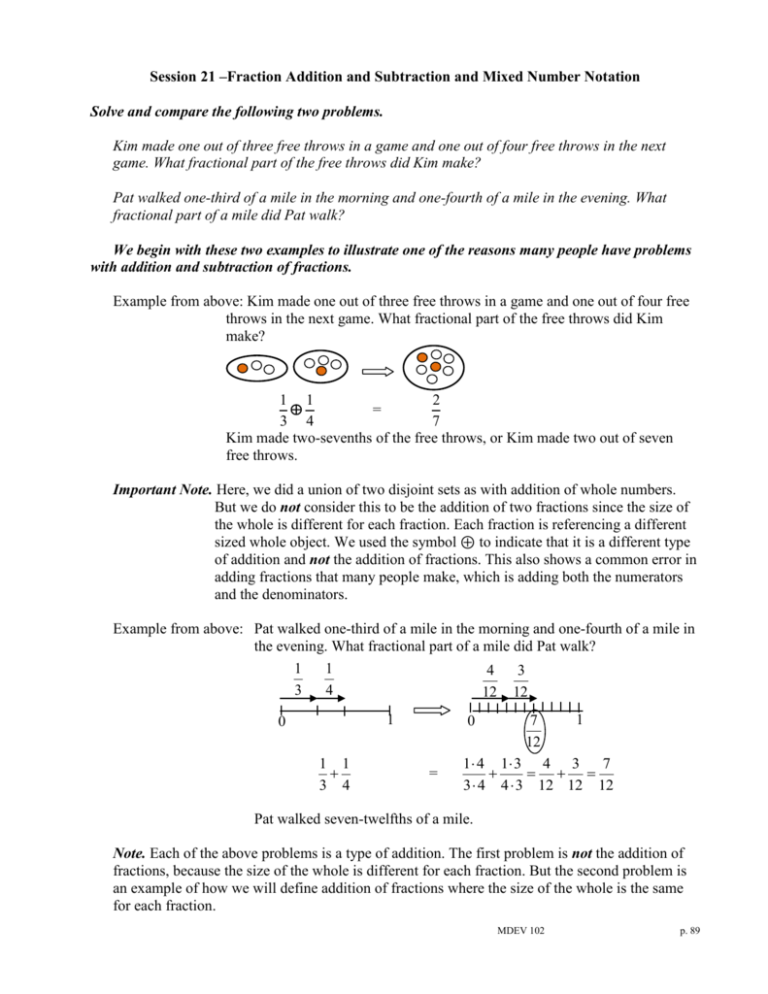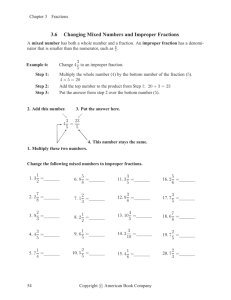Session 21 –Fraction Addition and Subtraction and Mixed Number
advertisement

Session 21 –Fraction Addition and Subtraction and Mixed Number Notation Solve and compare the following two problems. Kim made one out of three free throws in a game and one out of four free throws in the next game. What fractional part of the free throws did Kim make? Pat walked one-third of a mile in the morning and one-fourth of a mile in the evening. What fractional part of a mile did Pat walk? We begin with these two examples to illustrate one of the reasons many people have problems with addition and subtraction of fractions. Example from above: Kim made one out of three free throws in a game and one out of four free throws in the next game. What fractional part of the free throws did Kim make? 2 1 1 = 7 3 4 Kim made two-sevenths of the free throws, or Kim made two out of seven free throws. Important Note. Here, we did a union of two disjoint sets as with addition of whole numbers. But we do not consider this to be the addition of two fractions since the size of the whole is different for each fraction. Each fraction is referencing a different sized whole object. We used the symbol ⊕ to indicate that it is a different type of addition and not the addition of fractions. This also shows a common error in adding fractions that many people make, which is adding both the numerators and the denominators. Example from above: Pat walked one-third of a mile in the morning and one-fourth of a mile in the evening. What fractional part of a mile did Pat walk? 1 3 1 4 4 12 1 0 1 1 3 4 0 = 3 12 7 12 1 1 4 1 3 4 3 7 3 4 4 3 12 12 12 Pat walked seven-twelfths of a mile. Note. Each of the above problems is a type of addition. The first problem is not the addition of fractions, because the size of the whole is different for each fraction. But the second problem is an example of how we will define addition of fractions where the size of the whole is the same for each fraction. MDEV 102 p. 89 Addition and Subtraction of Fractions with Common Denominators We begin with adding 2 3 by using a rectangle to represent the whole and divided into ten 10 10 equal-sized pieces. First, we shade 2 of a whole rectangle. 10 Next, to show the addition, we shade We now have 3 more. 10 2 3 5 5 of the whole rectangle shaded. So, we conclude that . 10 10 10 10 Notice that we added tenths to tenths and our answer was in tenths. It appears that the rule for adding fractions that have the same denominator is to add the numerators and keep the common denominator. 5 as in the previous sessions by using the Fundamental Law of 10 5 1 5 1 5 55 1 Fractions or by division by the greatest common factor . So, we have 10 2 5 2 10 10 5 2 2 3 5 1 . 10 10 10 2 We can still simplify the answer Similarly, we subtract 7 3 by using a rectangle to represent the whole with 7 parts shaded. 10 10 7 3 of a whole from which we will take of the whole rectangle away. 10 10 3 Next, we subtract of the whole rectangle by crossing out or unshading 3 of the parts. 10 This represents the We conclude that 7 3 4 2 which can be simplified to . 10 10 10 5 MDEV 102 p. 90 Here are two more examples with models. Use fraction strips for 3 1 5 5 = 3 1 5 5 Use an area model for 4 5 7 5 9 9 7 5 9 9 12 3 1 1 1 9 9 3 = Addition and Subtraction of Fractions with Unequal Denominators 2 1 ? As with problems with common denominators, we can draw a 3 4 diagram. We have a problem since all the pieces are not the same size. Though, after cutting each piece to make pieces of the same size, we are able to work the problem. In other words, we change the problem so that the fractions are equivalent fractions with common denominators as illustrated below. Now how can we add 2 1 3 4 = 2 4 1 3 8 3 3 4 4 3 12 12 = 8 3 11 12 12 Note that we cut each third into fourths and each fourth into thirds so that each small piece represents one-twelfth of a whole square. Further, we note that the LCM (3, 4) = 12, so we have chosen 12 for the least common denominator. Addition and Subtraction Rule In summary, to add or subtract fractions, it is sufficient to change the fractions so that they have common denominators. Then we add or subtract the numerators and keep the common denominator. Finally, we simplify that answer, if it is not already in simplest form. Here is an example adding more than two fractions at a time. Find the sum 2 1 1 4 . 5 10 2 25 First, find the least common multiple of denominators. This will give us the least common denominator. We find LCM (5, 10, 2, 25) by the prime factorization method. 5 = 5, 10 = 2 ∙ 5, 2 = 2, and 25 = 52 So the LCM (5, 10, 2, 25) = 2 ∙ 52 = 2 ∙ 25 = 50 MDEV 102 p. 91 We now change each addend to fractions with the common denominator. 2 1 1 4 5 10 2 25 2 10 1 5 1 25 42 5 10 10 5 2 25 25 2 20 50 5 50 20 5 25 8 50 58 50 29 25 1 25 50 8 50 4 25 58 and then changed it to a mixed number. A more detailed illustration 50 follows where we show each step: first simplify the fraction, then since the fraction is an improper fraction, split the improper fraction into a whole and a fractional part, and then write as a mixed number. 58 29 2 29 50 25 2 25 Note that we simplified 25 4 4 1 25 25 25 1 4 25 4 , is a mixed number. Any improper fraction can be also be expressed as a mixed 25 number because there is more than one whole in the improper fraction. This answer, 1 Changing an Improper Fraction to a Mixed Number Consider the following illustration where each rectangle represents one whole and each rectangle is cut into eight pieces of the same size. 19 . Also, the illustration has two whole rectangles 8 3 and three-eighths of another rectangle, that is, it shows the mixed number 2 . So, we have 8 19 3 illustrated that 2 . The model also motivates a method for changing from an improper fraction 8 8 The illustration shows that the improper fraction MDEV 102 p. 92 to a mixed number. Since each group of 8 pieces is a whole piece, we could change to a mixed number by dividing 19 by 8 to obtain two whole pieces and three pieces remaining. 3 19 8 2 8 a The problem shows that we can think of a fraction as another way to represent division, a b or b 13 as b a . For example, we may change an improper fraction like to a mixed number by division 5 where we interpret the fraction as division. We will write the remainder as a fraction. 13 13 5 5 We take the remainder of 3 and write it as 2 5 13 10 3 3 3 13 3 of another whole giving us 2 . So 2 . 5 5 5 5 Changing a Mixed Number to an Improper Fraction 3 Suppose we need to change 4 into an improper fraction. (We will need to do this when we 5 start multiplying and dividing fractions.) We illustrate where each rectangle is one whole. Now divide each whole rectangle into five equal parts to illustrate 23 . 5 3 3 5 5 5 5 3 45 3 23 . 1111 5 5 5 5 5 5 5 5 5 5 Notice that the process for finding the number of fifths is to cut each of the four wholes into five3 4 5 3 23 fifths and add the three-fifths for a total of twenty-three fifths, i.e., 4 . 5 5 5 We have shown that 4 Addition and Subtraction of Mixed Numbers The addition and subtraction of mixed numbers may be accomplished in the same manner as we added and subtracted whole numbers. In other words, we add the values by corresponding placevalue with mixed numbers that means we add or subtract the whole number portions and the fraction portions separately making exchanges when needed. We demonstrate the process with models in the following examples. MDEV 102 p. 93 2 1 Example: Find 2 1 . 5 5 2 2 5 1 + 1 5 3 = 3 5 Note that we added the whole and the fraction portions separately. 4 2 Example: Find 3 1 . 9 3 We first change the fraction portions to a common denominator. 4 9 2 +1 3 3 = = We add the whole and the fraction portions separately. 4 9 6 +1 9 3 4 We change the improper fraction to a mixed number 10 10 1 1 4 4 4 1 5 . 9 9 9 9 = 10 9 5 1 9 2 3 Example: Find 4 2 . 5 5 Here we need to make an exchange in order to subtract the fractional parts. So, we 2 7 need to cut one of the four whole rectangles into fifths, e.g., 4 3 . 5 5 4 2 5 – 2 3 5 = 3 7 5 – 2 3 5 MDEV 102 = 1 4 5 p. 94 4 2 Example: Find 3 1 9 3 We first change the fraction portions to a common denominator. 4 3 = 9 6 = –1 9 4 9 2 –1 3 3 We need to make an exchange. We cut one whole square into nine equal parts. 4 4 13 That is, 3 2 1 2 . 9 9 9 We subtract the whole and fraction part separately. 2 13 9 6 9 7 1 9 –1 = Mixed Numbers Versus Improper Fractions Note. It is often much easier to add and subtract mixed numbers without converting to improper fractions. Changing to improper fractions increases the number of computations and makes many problems harder to simplify. Example. Compute 12 13 8 two ways: as mixed numbers and as improper fractions 7 15 21 As mixed numbers 13 8 91 40 12 7 12 7 15 21 105 105 19 131 26 20 105 105 As improper fractions 13 8 193 155 12 7 15 21 15 21 Find the common denominator. Change to a mixed number. Change to an improper fraction. 1351 775 105 105 Find the common denominator. 2126 26 20 105 105 Change to a mixed number. The multiplying and dividing of the large values greatly increases the chance of error. Also, if the fractions needed to be simplified, the simplification with the large values would be much more difficult when using the improper fractions method. MDEV 102 p. 95



